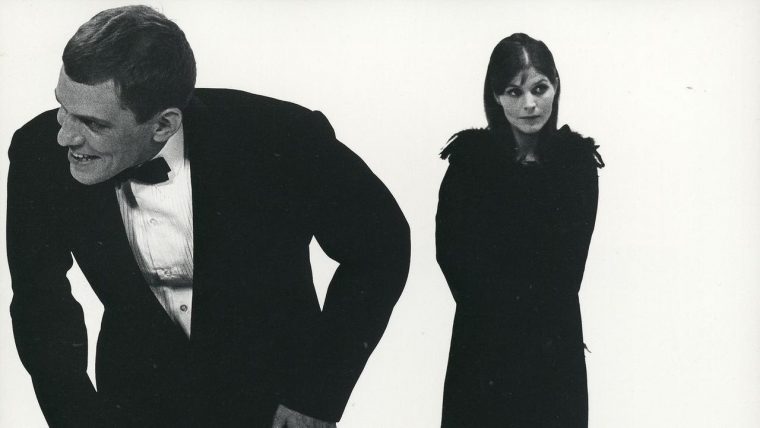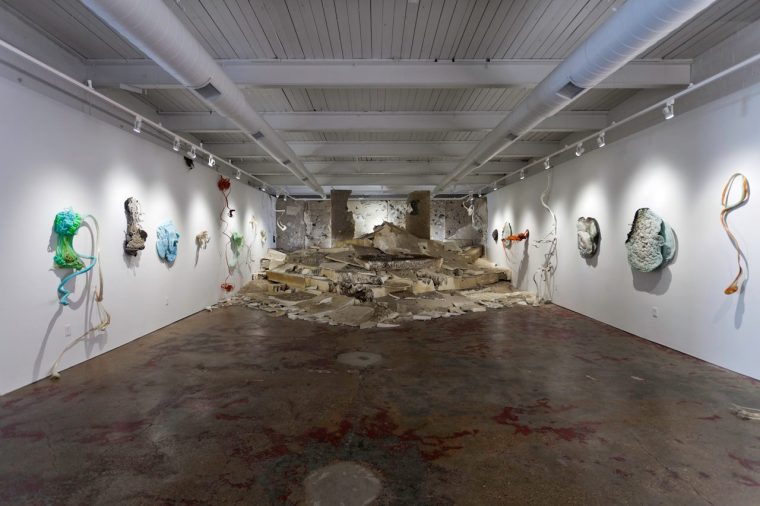Detroit-based Scott Hocking visited Indianapolis in January and selected the former RCA Factory at Michigan and LaSalle as fodder for his installation in the main gallery. “It immediately grabbed me,” Hocking explained of the experience. “The RCA history was interesting enough. But the building was last used as a recycling plant, and was filled with now abandoned, un-recycled waste: plastic, paper, foam — thousands of objects. The irony of these mountains of recyclables is that they would never be recycled. A huge pile of military grade plastic cases, with ominous stencils: ‘laser firing simulator system,’ ‘interrogation kit,’ ‘casualty evacuation kit,’ ‘tank weapon gunnery simulation system.’ Pallets of clothes and books, including dozens of old hymnals. Plastic pill and dish soap bottles strewn everywhere. Giant fragments of fast food and gas station signage: McDonald’s, Steel City, Family Dollar, Wendy’s. And a monster stack of Styrofoam slabs and wedges — melted and distorted from failed arson attempts. The whole place was crazy and great.”
Hocking spent three weeks in Indianapolis gathering materials from the site, documenting, researching, and creating his installation. He hauled over 100 massive hunks of burned Styrofoam, multiple plastic blobs melted by fires, fragmented fast food signage, nifty anthropomorphic food-character murals, and dozens of other artifacts. He brought this all to Tube Factory. And he worked onsite while living in Big Car’s neighboring artist residency home. The resulting installation uses the main gallery as a kind of ceremonial site — the burned Styrofoam mountain could be a dystopian temple or future glacier.
Also featured — in the eastside space adjacent to the cartoon food doodz from the old RCA building — is a sampling of Hocking’s Bad Graffiti series. These are photographs he takes of the work of renegade painters. The series, featuring photos taken most often in Detroit, now includes discoveries from his Indianapolis visits.
In the video room, Hocking blends images from projects he’s competed in Detroit and rural Michigan with footage from his recent work in Indianapolis — offering a look at his often solitary and meditative process. The videos also highlight Hocking’s love of nature and ways the natural and man-made worlds are really one.
Hocking’s artwork has been exhibited internationally, including the Detroit Institute of Arts, Cranbrook Art Museum, the Museum of Contemporary Art Detroit, the University of Michigan, the Smart Museum of Art, the School of the Art Institute Chicago, Contemporary Art Museum St. Louis, the Pennsylvania Academy of Fine Arts Museum, the Mattress Factory Art Museum, the Museum of Contemporary Art Chicago, the Kunst-Werke Institute, the Van Abbemuseum, and Kunsthalle Wien. He was recently awarded a Kresge Artist Fellowship, and is represented by Susanne Hilberry Gallery.
“The coyotes roaming Detroit fascinate artist Scott Hocking. It is an animal that is adaptable and gregarious, yet also solitary and rejects human domestication. Hocking encounters them on his sojourns through the parts of the city where post-industrial urban landscape is in the process of being reclaimed by nature. He creates photographs, sculpture, and assemblages in these places of transition. Likewise, he is a coyote-like roamer in pursuit of evidence and archeological specimens created by the modern human species. The coyote is a frequent character in the folklore of the Western World going back to Mesoamerican cosmology—a picaresque figure that has the ability to assume both human and animal form. It is easy to conjure such a fantastical character around Hocking, because he is more of a scavenger than flâneur, and his work is more mythology than documentary.”
— Laura Mott, Curator of Contemporary Art and Design, Cranbrook Art Museum
The exhibit, curated by Shauta Marsh, is made possible by The Andy Warhol Foundation for the Visual Arts.
The exhibit is open Monday through Friday, 9 am – 6 pm and Saturdays 11 am-3pm.
Photo: RCA, installation of found materials, Scott Hocking


